
Joe's Stories from the Road
for the month of May 05
May 28
The EGO: Lose Some, Win Some
Before going into Canada I wanted to get some of my
money exchanged into Canadian currency. I figured I would get a better
exchange from a US
bank so I decided to stay in Bonners Ferry,
Idaho, before going on. The banks would be open
the next morning. I stopped
at the Kootenai Valley Motel. Small motel with well kept yards and a lot
of flowers. You knew someone loved the place. I was checking in and the
lady at the desk, Diane, was filling out the paper work. She asked some
questions about the bicycle and I told her. After a minute she slid the
half filled out paper across the counter and said, “This one is on me.”
She wouldn’t let me pay for the room. She has recently e-mailed
and somehow I can’t pick up her e-mail to write back. Diane, if you are
reading this try again.
ridejoeride@inthehills.com.
And thanks for being a part of this incredible project.
The Canadian Customs people asked me a few questions and waved me on
into Canada.
They did, however, doubt that I could ride a bicycle to
Banff, Calgary, and back to Glacier National Park in Montana in seven days. Well, I wasn’t sure
either but this is day 6 and I should be in Montana in two more days. So, I was only off
a couple of days.
From the border to Radium Hot Springs I rode in a
huge valley with snow-capped mountains on each side. It wasn’t until I
left Cranbrook, going to Fort Steele, that I got my first look at the
Rockies on this trip. The Rockies are distinctly different from the other mountains.
I was fairly certain that this is the way it would look for the next few
days. Wrong. When I checked in at the entrance to Kooteney National Park,
the lady said the elevation change would be about 2,700 feet and I
thought she said 14 miles to the top.
Well, I rode through a very narrow cliff canyon where the road
shares the narrow gap with a swift flowing creek. And I started up.
Climb, climb, climb. I was watching the odometer. Four miles. Five
miles. Then seven. “Wow,” I think to myself, “I’m halfway up.”
But in another mile I’m through the pass at almost 5,000 feet.
The attendant had told me the distance in kilometers but I had heard it
in miles. A pleasant surprise.
A mile down the other side I remember why I always
wanted to come back to Kootenay.
There is no way to describe this beauty. And it is wilderness.
There are snow-capped mountains on each side with the
Kooteney River flowing through the
valley. Tall evergreens point skyward by the millions. On the ride
through I saw several elk, one mule deer and a lot of small animals.
I stopped for lunch on the banks of the river just off the highway.
I laid my food out on the banks of the river and took photos of the
river with the mountains in the background. Then I set down to eat.
After a few minutes a man in a pickup stopped. The guy was obviously
nervous. He yelled, “Hey buddy, there is a bear eating on the other
side of the highway. I walked up to the highway and there he was and
he was big and black. I knew that he probably liked peaches in the
can but I was in no mood to share with him. I hurriedly packed and
rode up the highway while the truck driver stayed between us. Later,
I was told that the bear would not have bothered me but I didn’t
know that at the time. Actually, I still don’t know that.
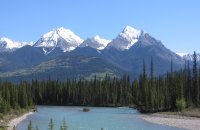
Kootney
At the north end of Kootenay I crossed the
continental divide for the first time.
The divide is where rain (or snow) falling to the east goes
to the Atlantic Ocean and rain falling to the west flows to the
Pacific Ocean. Cool.
I will cross the Divide probably 12 more times this summer on
the bicycle.
When you leave the divide it is 25 miles downhill to
Banff, Alberta. Three miles
out of town eight bicycle riders came up the ramp and rode with me into
town. It wasn’t planned.
It just happened.
Thanks men. It may be the
only bicycle escort I’ll get during the trip.
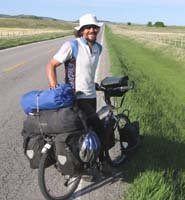
Before reaching Cockrane I met my first really
serious bicycle adventurer. He was Carlos Gonzales and was from Barcelona, Spain.
Carlos had bicycled from Chili, South America,
to Cockrane. He had covered nearly 18,000 miles in two years and was
going to Prudo Bay, Alaska.
Speaking of my age and the fact that I had done this before he said, “I
guess you never get this out your system?” I guess not Carlos. Carlos
was 31 years old. He saw
Rocinante printed on my bicycle and laughed and said, “Oh, that’s
______’s horse”. That was a first. (Editor’s note- Sorry. Figuring out
whose horse is part of the story.)
I’m in bicycle country. The next day, I left
Cockrane, Alberta,
on a three-mile uphill climb out of town. Two women passed me by. That
male ego just couldn’t handle it. I laid into those pedals and stayed
with them all the way up the climb. I thought I was going to bust my
heart. At the top they stopped for a rest and drink. They probably
stopped just so I wouldn’t kill myself. They were electrical engineers
from Eastern Canada
and both had run in the Boston Marathon. They signed my book and I told
them that I wouldn’t be able to keep up with them. As if they didn’t
already know that.
Then I got my turn.
Two young men in their twenties passed me.
They were riding with three young women.
One of the young men, as he passed, commented, “You’re kinda old
pushing that much pack.
Aren’t you?” I sized him up
for a quarter mile. Stayed
real close. Then I decided,
“Yes.”I pulled up beside him and
looked over and said, “See you in Calgary, big man.”
And I started pulling away from him and his little flock.
Twenty-four miles to Calgary.
I would check their position through my rear view mirror.
I would let them catch up then I would pour it on.
All the way to Calgary and he had to eat my dust.
I figured his problem was his women friends but I would have
never told him that. Of
course, his women friends may have been as good as the engineers.
It may have been his problem.
On the river bank in downtown Calgary I rode up to a
Bicycle Festival. I met several
interesting cyclists and saw some fascinating bicycles.
The lady in charge of the project asked about what I was doing
and after a short time a reporter and photographer from the Calgary
Herald came over to talk to me.
In 1967, I had met a reporter for the Herald and he understood real
quickly that I was not a man of the world and didn’t have much money.
He took me and my bicycle into the Herald building and
photographed us in the newsroom and wrote a story.
Afterwards, he sent my mom a copy of that article.
When I left the building he wished me luck and gave me five
dollars. It was getting late and
I rode down to the construction site of the Husky Tower and slept among
the construction equipment under the new Tower being built.
Today, after the Festival, I rode down to the Husky Tower which
is renamed to the Calgary Tower and took many photos.
It was good to reminisce about the ‘67 trip in Calgary and to see
all the bicycles. Back then,
there were no bicycle riders on the streets.
May 19
Vietnam- Different Perspectives
Sandpoint was another place where I would find an
awesome American story. At
the beginning of this journal, I told you that I got on the bicycle
rather than reenlist into the US Air Force because I knew they were
going to send me straight to Vietnam.
And I didn’t want to go.
Over the years I had been bothered because I had not gone.
I had lost two good friends to the war in Vietnam.
And several other buddies had gone and not come back in good
shape. I felt guilty.;
When my children were teenagers, we visited the Vietnam Veterans
Wall in Washington, D.C. My
wife and children had walked to one end and left me alone with the name
of one of my buddies on the wall.
I became emotional and was crying, just standing and looking at
his name. After a few
minutes I felt an arm hug me around my shoulder.
I looked around and there stood a Vietnam Soldier, still wearing
the green field jacket with the drawstring.
He had jeans on and tennis shoes and was wearing a two-year-old
graying beard. He looked at
me with tears in his eyes and said, “It is okay that your name is not up
there on that wall.” I
cried more but I understood.
All of those emotions came back to me last night as I heard
another Great American Story.
Remember down in California I told you about Jerry and
Marcy Clausen who had seen a newspaper story a bout me and had found me
and drove over a hundred miles to be with me for a few hours? I had
stood up for them at their wedding forty years ago.
They brought photos of that wedding that I had never seen.
I had forgotten that at one time I was so young.
Well, at that visit they told me a little about their life.
Jerry had retired as a deputy sheriff for the Sonoma County
Sheriff Department and Marcy had had a career as a nurse.
They had two biological children and over the years had adopted
eight other children to raise.
I take my hat off to Jerry and Marcy.
They told me that one of their daughters who was from Vietnam
lived in Sandpoint, Idaho, with her husband and two children.
They said that I had to stop and see them.
Well, I did and stayed all night and they took me to breakfast
the next morning. They were
Les and Hien Clark and their children were Cohen and Faith, four and two
years old. Very precious little boy and girl.
Here is their incredible story.
In 1975, the United States was doomed in Vietnam. It was a war
that crumbled beyond our control.
President Gerald Ford, feeling a need to do something positive
and at the encouragement of some very strong and faithful people
committed two million dollars to go to Vietnam and rescue as many as
2,000 children who were part American and part French.
Our country knew that they would not fit in that culture and most
probably be murdered anyway.
Three planes were to bring the children out of Saigon. It was
named OPERATION BABY LIFT.
The first plane loaded but most of the children had not arrived from the
orphanages yet. The plane
had to leave. It was war.
Only 300 children were loaded.
Over a hundred were put in the top bay of the huge C5A Super
Transporter. The rest were
strapped in on the belly of the big jet.
Pillows and quilts were laid down so they would have a safe way
to fly. The plane left
Saigon and at 20,000 feet the back bay door began opening and tore most
of the controls off of the plane.
The pilot turned back to Saigon with very little control.
He brought the plane down but bellied into the rice paddies.
The plane went airborne again and jumped over the river to hit
the rice fields again. This
time the C5A broke apart.
The children in the floor of the plane were totally lost.
The section above broke apart and became a bobsled sliding at
enormous speed across the rice paddies.
Those children made it.
The pilot and a nurse made it also.
Those children were loaded into trucks and were taken screaming
to one of the other Transporters and put aboard again.
That time they flew to San Francisco.
One of the five to seven years old girls that was on the C5A that
crashed and put on the other plane was my new friend Hien Clark of
Sandpoint, Idaho, and the daughter of my friends, Jerry and Marcy
Clausen. I become emotional
writing this for you.
We spent most of the night talking.
Hien thinks her father was from France because she spoke French
as well as Vietnamese. She
said she remembered as a little girl climbing under furniture when the
bombs would start going off.
They would go for hours.
She had a pet monkey and near their home a barbed wire fence had
been put up to protect the children from the land mines.
Once her monkey went behind the fence and she went after him.
She didn’t get hurt.
When the nuns were rounding up these children to get out they were told
they could only take children five years old or younger.
Marcy, Hien’s American mother, told her that they probably had
faked her ID papers because she had all of her permanent teeth and she
may have been six or seven. Jerry and Marcy had already adopted one
Vietnam child. So when
OPERATION BABY LIFT arrived they were given another child and it was
Hien. A few years ago PBS
made a documentary about OPERATION BABY LIFT and the Clarks had a copy
of the video. Before they
put it into the TV they showed me photos that were taken by the Clausens
shortly after Hien had come into their family.
The video started and there was Hien rushing across the tarmac to
board one of the two planes that she had gotten on that day.
I asked Hien how she felt about all of this.
She told me that God had blessed her and that she was an
American. She said, “How could I
not be blessed? I have a mom and
dad who love me. I have a
husband that loves me and I have two beautiful children. I have a family
of brothers and sisters that love me.
I thank God everyday.”
She said that she didn’t have to know about her past in Vietnam.
She and Les are 35 and 36 years old and she told me her birthday
was April 23.I asked her how
she knew that. She replied,
“That was the day I landed in America.”

May 18
Bicycles, Cops, Cops on Bicycles
Bicycles have become a popular and efficient way to travel America if you have the time to put into it. There are several thousand bicyclists who travel across America every year now. Of course there was only one in 1967. I’m sorry. I just had to write that. Bicycles are efficient in other ways as well. I had ridden over eighty miles into Sandpoint, Idaho. It was late and I was taking a break in the their beautiful city park along the lake shore. I was sitting on a rock near Rocinante and just watching the locals. There was one carload of young men with their music so loud it was vibrating the boulder I was setting on. They were trying to impress the girls in the car a few parking spaces down. One young man in his red Corvette was turning doughnuts on the parking lot. Never saw who he was trying to impress. Then there was this unusual situation where a man was sitting on a ATV that was sitting up in the bed of a pickup truck that may have been four feet off the ground itself. And he just kept sitting up there revving the ATV engine and looking around. Now there were a lot of other people with their families who were being annoyed by these folks. About this time, in unison, these three groups started getting in their autos. They all quickly left the area, including the Corvette. I looked over at the entrance to the park and there rode two police officers on bicycles. Hey, that is cool, I thought. Police on bicycles. They rode casually through the park and then came back by where I was sitting on the boulder. I asked them if Rocinante and I could have our photo taken with them. Stephen Chamberlain was the taller one of the two and Chris Giese was his partner. I wouldn’t want to tangle with either of them. It was obvious that those others who thought themselves BAD didn’t want to tangle with them either. They left.
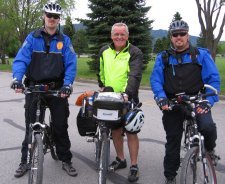
We had a great conversation. They explained how effective the bicycles were. They said that they had actually ridden up on crimes in progress because they were not noticed until it was too late. Chris said when a criminal runs they just stay with him until he has worn himself out. Then they take him down. If they see the criminal going over a fence and may get away, they tackle. I can just picture this. A bicycle policeman bulldogs a criminal from a flying bicycle. Hey, it’s rodeo time. The next morning these friendly cops provided me with a bicycle cop sew-on patch and one for the Sandpoint Police. Both patches will grace my 14,000 mile bicycle jacket.
May 17
River Race, Apples, The Grand Coulee, and a Cowboy Legend
The twenty-five mile climb into Stevens Pass took five hours. For me, that was another passage. Once over and down
the other side, I had started the trip across America and the West Coast was
behind me. Pretty uneventful
for twenty-five miles but then Rocinante and I came upon the Wenatchee River.
It became a race. Have you ever raced with a river? To my immediate left
there were towering cliffs. On my right was a twenty feet drop to a
raging river on its race to meet with the Great Columbia. We pulled in
beside the white water just below us and the race was on. For the next
ten miles it was all out. We
got up to thirty miles an hour and looking down, the white water must
have been dropping over boulders nearly as fast as we were spinning
wheels. The cliffs on the other side were wet from the spray of pounding
water.
Suddenly we were out in a valley. The river turned
right and we kept on going. We had entered the Bavarian town of Leavenworth. Leavenworth must look just like a German town.
Shops and restaurants were everywhere. After a stop for food,
Rocinante and I went on down into the Wenatchee Valley. A short distance later, the
Wenatchee River that we had raced came back out
near the highway. Only this time it was spread out and not as wild, yet
still an untamed river. The entire valley on both sides of the river
that we crossed six or seven times was carpeted in fields of apple
trees. Near town the sign read, “Wenatchee, Apple Capitol of The World.”
And Mr. Ken Thompson, I’m really sorry but Watsonville is still NOT
the Artichoke Capitol of The World.
After crossing the Columbia
at Wenatchee I rode south as I did in 67
in order to ride up the Grand Coulee from
Soap Lake, Washington.
The Grand Coulee is an ancient riverbed that was
created during the receding ice age of centuries ago. The coulee is
probably a mile wide and is 600 feet deep. On both sides of the coulee
are these straight up 600-foot cliffs. Inside the coulee are a series of
lakes that are remnants of the old river. In 67 there were maybe a dozen
of these small lakes and the highway kinda went up the middle and moved
back and forth to go around the lakes. Now the coulee is a water storage
area for irrigation and the highway goes up the side of the coulee.
After twenty fives miles it ends with high cliffs in front of you. It is
somewhat a horseshoe of 600-foot tall cliffs. Of course a highway has
been chiseled up the side of the cliffs so you can drive to the upper
coulee. At the horseshoe cliffs are the dry waterfalls of eons ago that
would have dwarfed all the waterfalls of the world. It was formed during
the ice age when the Columbia River was
blocked by millions of tons of ice and the river was forced to reroute
itself. I bought a video so David could share this incredible story with
our children who are participating in this school program.
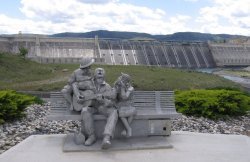
Statue with Grand Coulee Dam in background.
After fifty miles of bicycling through the Grand
Coulee I arrived at the Grand Coulee Dam on the
Columbia. Awesome, awesome, awesome. It still is
the largest concrete pour on earth. And there at a viewing place of the
dam, coming from two different automobiles, I met Tammy Nichols from
Lexington and Brian Swail from
Somerset. Brian had his friend with him from
Tennessee, Doug Smeleer. Small world.
Remember how I told you about incredible people
I’ve met on this trip? Well another one showed up in
Creston, Washington. I love horses and have
been a horseman most of my life. Had some years when I wasn’t around
them but still had a great appreciation for them and the people who love
them. Back when I was just a kid I would go to my aunt and Jack Bowen’s
home and watch TV. We didn’t have television. One of my favorite
programs to watch was the rodeo championship. I used to know some of the
GREATS names but they have left me. But since I had my own horse at the
time and watched the rodeos on TV, I would dream that someday maybe I
could ride a bronco in competition. After all, I did break horses to ride. Wayne Lee Hearne, from
Stanton, was one of the people who I broke horses
for. I earned $25.00 per horse.
There is a reason for telling you all of this. I
stopped at a café in Creston and struck up a conversation with locals,
Jack and Jo Robertson. I told them what I was doing and Jo told me that
I had to meet a local hero and that he only live about a block away. The
man I was looking for was Deb Copenhaver. Because of my interest in
horses and in those rodeos of long ago, I wanted to meet this man. At
his doorstep I said, “Hi, Mr. Copenhaver. I’m Joe Bowen from Kentucky.” “Yah, I know
about Kentucky,” he replied. He invited me in since Jack and Jo had recommended that we
talk. On his dining room wall was a Kentucky Colonel commission. His
son-in-law was from Pikeville. He invited me to take a ride with him out
to his horse barn where he had a brand new foal. There I took some
photos of the 80-year-old cowboy in the barn with the mare and new colt.
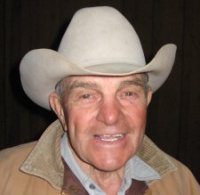
Cowboy legend Deb Copenhaver
Back at the house we got into why I was so interested in talking to him.
In 1955 and 1956 he was the World
Championship Rodeo Bronco Rider. During his career he rode in all the
great events of the International Rodeo Association. He rode them at the
Calgary Stampede. Pendleton, San Francisco Cow Palace,
Madison Square Gardens,Cheyenne and Reno to mention a few. Deb is featured in six
Cowboy Hall of Fame Museums around the country. I had my photo taken
with him and the 1955 World Champion Bronco Rider saddle. Deb, who is a
very spiritual person and a man of Faith and his beautiful wife, Cheryl,
invited me to stay all night. Deb fixed my breakfast the next morning. I
don’t know for sure why I got to do this, but meeting The Great Bronc
Rider, Deb Copenhaver, was a
real treat and I’m thankful.
At Twin
Falls Idaho there are no FALLS. The
water is diverted through turbines to make electricity. At Klamath Falls I could not find any FALLS.
There is a beautiful twenty mile long lake but no FALLS (that I found).
There are no FALLS after the word Spokane
as in Spokane Washington. But there are three absolutely
awesome water FALLS on the Spokane River in downtown Spokane, Washington.
Thought you’d like to know that.
And while I was walking through the park to take photos of the
waterfalls a man with his wife asked, “You’re from
Kentucky?” My answer was yes and we struck up a
conversation. He was Devon Thomas and played football for John L Smith
at the University of Louisville
in 2002. Devon and his beautiful wife, Melanie, live in
Moscow Idaho, where Devon works for Idaho University.
Happy birthday, Melanie.
May 15
Natalie, Kentucky Horses, Rain, $69 plus tax
Thursday, Cindy and I took the Airporter to the Seattle
Tacoma Airport to pick up my youngest daughter, Natalie. Once together, we got in her
rental car and drove to the Space Needle. It is a 600 foot tower with a
restaurant on top. That was our lunch stop. After leaving the tower I
got turned around several times trying to get out of downtown and to the
ferry that would take us to Bremerton. I became helpless. I couldn’t figure
out how they had arranged the one-way streets. Impossible. I saw a
Seattle Police car parked and I walked over and told her my problem. She
said, “You follow me and I’ll take you to the ferry. She was Tracy
Beemster and she took us to the ferry. I asked if I could mention her
name on the web and said it was okay.
Seattle streets may be a mess for a country boy from a town of a few hundred
people but their police officers are very helpful. Thanks.
It was great being with Natalie- especially up in
the US Northwest country. We talked a lot about David and her making me
Papa Joe one more time. That is the best title I’ve ever had. We took
the ferry across the inland waterway at Port Angeles
over to Vancouver Island, British Columbia, Canada. Once on the ferry at Port Angeles
we were looking at a monstrous super-tanker ship being serviced. I just
didn’t know they were so big. Across the entire length of the ship were
these huge letters, NO SMOKING.
We didn’t schedule very well and got to Bowen Island
in British Columbia, Canada, about an hour too late to talk to the
children at Bowen Island School.
To anyone from Bowen Island who is reading this, I now have another excuse
to come back to Bowen Island and visit the school and tell you about
Bowen, Kentucky. Some of the children at Bowen, Kentucky, already know about you.
And Natalie fell in love with Bowen Island. Said she had to take David back to visit your beautiful island.
When the ferryboat landed at Snug Cove Natalie told me that it was like
a fairy tale. Oh, by the way, your ferryboat in 1967 carried maybe a
dozen cars. There must have been sixty on it Friday. I guess you folks
are growing just like everyone else. I was kinda hoping that they
wouldn’t find Bowen Island.
The only problem with Natalie’s visit was that it
was much too short. What an incredible young woman. Love you, Nat.
Natalie and I had one more stop to make before Nat
dropped me off at a hotel to drive to the
SEATAC Airport for the long
flight home. In ‘67, I stopped and visited Aulney and Verna Brown and
stayed several days. I wanted Natalie to meet them and for them to meet
Natalie. Aulney was raised at Rogers Chapel in
Powell County, Kentucky,
about five miles from Bowen. He left in 1936 and has never returned to
live. Verna had us a big meal prepared when we got there and we talked
for hours about home in
Kentucky. Natalie was amazed that an 86-year-old
man could still remember so many people and events of
Powell County.

Born, bred, trained, and developed in Eastern KY. Both of them.
I rode out of the Seattle suburbs today in a rain. I stopped by the home of my friend, Mark Smith,
in Duvall, Washington. The rain let up for about an hour so I could do something that I have
been looking forward to since I knew I was going to do the bicycle trip
again. I mounted this beautiful Rocky Mountain Saddle Horse and rode for
an hour. And that horse was born, raised and trained at the Van Bert Farm in Stanton Kentucky, about five miles from my Kentucky home. That is soooo cool. Thanks
Mark, and thanks to you, too, HT Derickson and Wilda. Your Rocky
Mountain Saddle Horses make the green hills of
Seattle look mighty good. There are several farms in Oregon
and Washington that own horses that have come from the Van Bert Farm or one line down
from those beautiful horses. HT and Wilda, it makes me really proud to
see your beautiful horses up here in the Northwest.
Mark took me to lunch. Afterward, I pedaled in the
rain toward Stevens Pass. That Pass has always been a distinct memory
from the ‘67 bicycle ride. I’ve been anxious to be on that highway
again. I knew I would be on it for two days. My plans were to stop at
Gold Bar and get a room at the only motel there. It was raining and
getting near to dark. The sign on the entrance read, $39.00. I walked in
to get a room. The lady told me the price was sixty-nine dollars plus
tax. I told her what was on the sign. She repeated, “Sixty nine plus
tax.” I told her, “Ma’am, I’ll sleep in the rain in the weeds before I
give you sixty nine plus tax.” Then I left. And I knew pretty much that
I was going to have a miserable night in the rain in the weeds.
I pedaled another five miles. Figured since I was
going to have to sleep wet I might as well be as far up the mountain as
possible. I’m climbing a five percent grade and into view came this
pretty little café. The sign read, “Mountain Index Café and Lounge.” I
thought, “Well, at least I won’t go to bed hungry, too.” Once inside,
the very first person I met started up a conversation. He was Steve
Curnutt and he owned the place. I asked him if he had porch or overhang
on a building where I could lay my sleeping bag out.
“Ah, I got an extra room over there in that apartment and it has
TV, shower, and fireplace. You can have it for twenty five.” I gave him
more than thirty-nine plus tax. He took me in the bar and introduced me
to everyone there and had the waitress to set me up with a huge bowl of
chili. It tasted great and was greatly appreciated. In the morning, in
heavy rain, I will cross Stevens Pass again on a bicycle,
thirty-eight years later. I know that once at the top it is about fifty
miles downhill to Wenatchee.
There I will sleep near the banks of the great Columbia again.
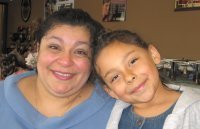
Elma and Brianna
May 12
Elma, Cousin Cindy, an Ode to Cliff, and a Kentucky Teacher in a Tree House
There are special people all around the bicycle
trip. It happened in Kentucky when we
were preparing to come to
California. We met them in
Lompoc before we left. And they just keep showing up. There is no way that we
can write about all of them. But I must tell you about one we met on our
way into the Washington Capitol Building.
Cliff and I stopped at a restaurant on Mothers Day
for lunch. An Hispanic lady and her little six year old daughter were
sitting at the table nearest us. They were only three feet away in a
crowded restaurant. Elma Castillo and daughter, Brianna, were their
names. Soon after we set
down we asked the waitress how to get to the capitol building. She was
in a kidding mood and told us she wasn’t going to tell us. Elma smiled
over at us and said, “I know and I’ll tell you.”
That started a conversation and we ended up sitting
at her table. We told her and Brianna about the school children in
Eastern Kentucky that we were going to be bringing America to by bicycle. Cliff made up
with Brianna and asked her some questions about her school.
We soon learned that Elma was one of seven children of migrant
worker family. Her father insisted that they were not immigrants but
were citizens of the United States of America. He never
would let them think any other way.
So, thinking herself as a citizen instead of a
migrant worker she decided she could have the American Dream for
herself. She worked herself through school and became a registered
vascular specialist. Now, with a good paycheck, she and her daughter
live the American Dream. Several times during our conversation with her
she became emotional. She
told us she had been hugely blessed and that she thanked God ever day.
She got up from the table when we were engaged in
conversation with Brianna. I saw her talking to the waitress. I got
Cliff’s attention. “You know what she is doing.” He said, “Joe we can’t
let her do that.” I told Cliff, “We can’t not let her do that.” She
walked back to our table smiling and Cliff was chastising her. “I’m rich
and I’m blessed,” was her response. She had paid for our lunch on
Mothers Day. I asked her if
I could write about her and give out her address and e-mail. She said,
“Yes.”
If you want to communicate with a wonderful person
who is an AMERICAN write or e-mail her and Brianna at Elma Castillo, P.O. Box 12557, Olympia,
WA 98508
or e-mail her at
olysky@msn.com. Tell her we
think she is awesome and thanks again for Mothers Day Lunch.

How many people get to ride their bicycles inside state capitols?
Half hour later, Rocinante and I were permitted to
enter the Washington State Capitol Building and have our photos taken
with a bronze statue of President George Washington. We both had to go
through the x-ray machine.
Speaking of Rocinante, I was talking to a friend who reads our reports
and didn’t realize that Rocinante was actually a horse, I mean a
bicycle. So I must get
better at telling my stories.
Usually I mount Rocinante from the left side by throwing my right
leg over. That is the same
way you do it with any horse.
Well, a couple of weeks back I had parked Rocinante the wrong
way, with the left side against the wall.
So I led, I mean rolled, him out onto the pavement and attempted
to mount from the left side.
I threw my 62-year-old right leg up over Rocinante and ended up
on my butt with Rocinante on top of me.
Cliff didn’t even check to see if I was hurt.
He hustled out his camera so he could get a shot.
I was laughing so hard I couldn’t get up for five minutes.
I’ve been watching the
kychaingang@blogspot.com
site hoping to hear from my buddy Cliff about us having to say goodbye.
I haven’t been able to get on-line for three days so maybe he has
written something. I can’t
send this tonight but tomorrow night I will.
Hopefully, he will have talked to you by then.

Hey, Cliff- This one's for you!
Anyway, the day that I was to go visit my long lost
cousin Cindy Pore in Port Orchard, Washington, we got up to go to
breakfast. Cliff told me that he was going to catch the AmTrack and go
to his daughter Sally’s graduation. She graduated from Berkley
with a PhD. I struggled to get through college in four years. Can’t
imagine a PhD. It was not easy seeing Cliff go. I had spent a month with
him I learned a lot from him, not only about computers and the GPS. He’s
got to be one of the most generous people I’ve ever been around.
Everyone he met got at least one compliment and generally two or three.
He was generous with the waiters and waitress and people who
helped him at the hotels. He
loves children. Talked to them every time we walked by a table where a
child was present. He bragged on the older women and they referred to
him as “young man.” He was older than most of them but they didn’t know
it or didn’t want to know it. I never saw him get frustrated with a
person the whole trip. He is just an incredible man. He was always
polite in all of his dealings. So, Cliff, if you are reading this I
really enjoyed your company and you are one powerful bicycle rider. When
I get to be 65 years old I want to be just like you. The best to you on
all your projects and thanks a million times for choosing to come back
to Eastern Kentucky to live. You have some great ideas about
our part of the country and I believe that the local people will embrace
you. Thanks.
I got on the ferry boat and rode over to
Vashon Island. The island is about 15 miles long, north and
south. One of the men that worked on the boat noticed the Kentucky
Unbridled Spirit and started talking to me about
Kentucky
and horses. Said he had always wanted to visit Kentucky and see the Horse Farms. When the
boat landed we were still talking and one of the people working with him
encouraged him to let me go. I pushed Rocinante up the ramp and then
mounted up to ride off. At that time an eighteen-year young man yelled
over at me, “are you going long distance?” “Fourteen thousand miles,” I
answered. The boatmen were
rushing me. About thirty minutes out two young men rode up beside me on
their bicycles. One was the young man who had yelled at me at the
landing. Their first names were Josiah and Nathaniel. They were great
young men and rode with me for several miles. They were very impressive
young men. I had my photo taken with them and our bicycles and they
wrote in my journal.
I started talking to some bicyclist at the next
landing and followed them onto the wrong ferry. I went to Seattle and then had to catch other ferries to
get back to Southworth where my cousin Cindy was waiting on me. She had
to wait over an hour longer. I asked her if she was worried about me. She thought that I probably was
talking and had missed my ferry.
The day after I arrived, Cindy took me and
Rocinante to Bainbridge Island where I spoke to some children at the
Island Wood
School. The children were
great. One young boy was of particular interest because he knew more
about Jack London than I do. The other really cool thing was that a Wolfe County
woman works at the school and it was she that invited me. A great young
woman and I encouraged her to come back to Wolfe Country and teach. We
are missing a lot by not having Brannin Musser in our school system. She
is talking about going to
Denver, Colorado to teach. Maybe she will still come
back to Eastern Kentucky someday.
Thanks, Brannin, for a great visit and for letting me talk to the
children and visit your awesome tree house at Island Wood.
May 7
Lotta Lumber, London Bridge (really), and a Rocket Car
Before Kentucky made the law that the coal trucks had to tarp their loads, one would
know what the major industry was by looking on the roadsides of the
Bert T Combs Mountain Parkway. You could
know visually in what direction the coal was being shipped and never see
a coal truck. On the west bound lanes the highway shoulders were black
from the fine pieces of coal that had blown off the trucks. And it was
almost humorous that you could tell which bridges were in need of
repair. When the big trucks roared across the ends of the bridges that
needed leveling the trucks lost more pieces of coal while crossing the
bump. The black coal was thick at each end of these bridges. For several
days here in Oregon and several miles
of California you knew what the industry was without seeing a truck. Small and large
pieces of tree bark lined each side of the road. They are in the lumber
business- big time.
Riding from Portland
to Longview, Washington, it became more obvious. The tree
bark was thick on the sides of the highway. When we got to the
Longview Bridge crossing the Columbia
River we saw where the logs were being hauled. Back in 1967,
the river was full of logs that a tug pulled down the river. That is not
done as much now as back then. The local people filled us in on that
subject. Crossing the big bridge, which is tall enough for major ocean
going ships to pass under, I stopped several times to photograph the log
yards. I have a friend in Morehead, Kentucky,
who is in the lumber business, Richard White and his mother and father.
They have very large log yards, but Richard, if you are reading this,
these loggers out here have you beat. Log yards are on both sides of the
river but the one in Washington had
to cover at least 400 acres. And I could see the entire operation from
the top of the bridge. Look for photographs on this later.
We stopped in St Helens on the way to the Longview Bridge
and talked to the local newspaper people. In 1967 when I rode through
St. Helens, Oregon, the a local news reporter came out on the highway
and interviewed me and took a photo with me and my bicycle in front of a
Lewis and Clark Trail historical marker. It is interesting that Lewis
and Clark came up and down that side of the
Columbia 200 years ago. This time the newspaper reporter looked up the old copy
about me cycling through there and they took a photo in front of the
same historic road sign. The reporter told me that I looked a little
different. We both laughed and I told him that 38 years makes a big
difference in some folks. They are going to try to run the old and new
photos together. And they said they would send me a copy.
When we came down off of Mount
Hood, we came from early spring to full spring. It was
warmer and the flowers were in bloom along with the dogwoods. The broad
leaf trees are completely filled out. For the last three days we have
been hearing and seeing weed-eaters and lawnmowers. Almost like back
home- but it isn’t the same. The people are good to me but they are not
the people that I have lived with all my life. I miss my people and the
Red River Valley and Taylorsville.
During the trip we meet all kinds of people and
most of the time they are interested in what we are doing. Many have had
dreams of adventure but just never got around to doing their dream. And
so far I have met several moderate adventurers but only three awesome
adventurers. The first one we met was a man and woman that Barbara and I
met on the London Bridge at Lake Havasu.
I told a friend about this meeting and he didn’t know that the London Bridge
is now in the United
States. He thought that the London Bridge was in London, England. Not so.
It was moved to the United States over 25 years ago. Back
to adventurers. It was very appropriate that we meet this couple on the
London Bridge since they were from
England. Their names were Pat Watson
and Helen Antcliff from Leicester, England.
They were traveling by motorcycle.
At the time we met them they had been on the road since September
l5, 2001 and had traveled 65,000 miles visiting over 50 countries. I
told them at the time that I would encourage the readers of this web
site to contact them by e-mail. So, will you drop them an encouraging
line. Their e-mail addresses are
www.patandhelen.co.uk and the
other is
patandhippy@postmaster.co.uk.
I would appreciate you trying to contact them.
Here is a photo of them and their motorcycle on the London Bridge.
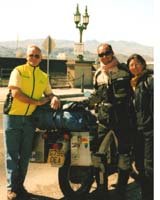
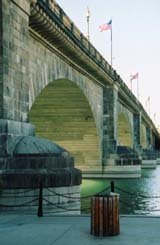
After today there is another adventurer that stands
out. And he has grey hair like Cliff and me. Well, not Cliff.
He has no hair, but if he did it would be grey. We stop at a
little market in the Washington
town of Toledo.
A young man dressed in a red jump suit was standing in front of me. He
looked like he may be a member of a racing team. So I asked him what he
was doing. He told me that he was on the team of the North American
Eagle. That is a jet car that is trying to beat the land speed record.
He said that the team had the rocket car on a local airport runway and
was going to do a test run this afternoon and invited us to stop by and
see it for ourselves. And we did.
I couldn’t believe it.
There was this huge long red
Bullitt that was really the fuselage of an Air Force fighter jet. On the
side were an eagle and the words, “North American Eagle.” They are the
world land speed challengers. They believe that within a year they will
have this baby cruising at 800 miles an hour. That will break the land
speed record. If no one minds, I will stick to bicycling. Once we were
on the grounds the whole team welcomed us. Cliff told them about the
bicycle trip and also that I had broken the stilt walking record by 1200
miles. They thought that was cool. They all understand breaking records.
The adventurer that this dream belongs to is Ed Shadler. I was
introduced to Ed and he posed with me and Rocinante in front of his
rocket car, North American Eagle. Rocinante is a privileged character. Of course I think that I am, too,
sometimes when I think about getting to do this 14,000-mile bicycle trip
again and meeting all these wonderful people and seeing this great
country again from the seat of a bicycle. And it is going to be a great
privilege telling the school children about all of this and encouraging
them to dream big dreams.
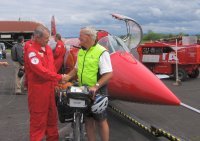
North American Eagle
Ed signed an 8x10 photo of the Eagle, “Good luck Joe on your 14,000 mile bicycle ride. May 7, 05”. Cliff was even asked to man one of the cameras after they got this baby down on the runway. We had to wait for an hour or so because they were filming, probably for the Discovery Channel. Finally it was ready. It took Ed a few minutes to crank that jet engine up but boy when he took off- he was gone. When he passed us I could only get one photo. He was long gone. He told us that he had only lit it up and instantly shut it down. Wow. I sure would like to see that baby when it breaks the land speed record. Maybe they will invite me.
May 4
From the Mountains to a Yacht
From Canby, where our old cowboy friend Jim lives,
to the timberline of Mount Hood was
cold bicycling. The tulips were still in small buds and the Easter
lilies were just blooming. Still, not hardly spring. When we got into Madras we had dropped, I guess, 1000 feet in
elevation. During the day my right knee, which has a bit of arthritis,
had been acting up a little and a muscle near my shoulder blade had
turned to a small knot and was bothering me. We found a drugstore for
some medicine. The next morning I felt much better.
The day is starting out awesome. We are on the East
side of the Cascades and sun is bright. What a day to be bicycling. We
had to climb probably 500 vertical feet out of the
Madras
valley. Now I’m giving up these guesses. I have a GPS on board and if I
got up and went to the bicycle and got my gear out I could tell you
exactly the elevation. But I’m just going to guess. The children that do
the study course with Bicycle Joe will have all that information.
We got up above town onto relatively flat farm
country. The hay fields ran for miles along the highway and miles away
from the road, too. I kept watching several snow capped peaks to the
west. Once out where I could get good photos without buildings and trees
in the way, I stopped and got the camera and a brochure. To the far
south there were three snow-capped peaks with the tops 3 to 4000 feet
covered with snow. The mountain range below them was massive but too low
enough to have snow. These three peaks standing together were named the
Three Sisters by the early settlers. Then, due west of us was another
massive snow covered peak, maybe taller than the Three Sisters. Its name
was Mount Jefferson. And far north and
a bit east of us was another peak. This peak had a little more class. It
was more perfect even though it was much farther away. That peak was
Mount Hood. Seeing these majestic mountain peaks while
standing in one place is not possible for me to describe to you.
Every mile up the highway I would look back to
check on each of these mountains. After about an hour I noticed that a
bank of clouds had cloaked Mount Hood.
I would only get to see the snow at the base for the rest of the day.
Another mile or two goes by and I noticed we have
turned west. I had thought that we would be riding in a direct line
toward Mount Hood since that is where we had planned to get to
before nightfall. In a few minutes I am flying down into the Deschutes
River Gorge. Four miles of
downhill and there is the green water, fast moving river in a narrow
gorge that appears surrounded by desert. I had just left green hayfields
up above. We crossed the river after a few miles and found ourselves on
the Warm Springs Indian Reservation. Their Indian Museum
was awesome and they let me take photos of the lumber mill operation up
the highway.
After climbing nearly 5000 feet in elevation we
made it to the side of Mount Hood and
stayed at Huckleberry Inn at Government Camp.
And then the next morning we are going down, down,
down, down, and down on the bicycles. It was the pay off for all the
climbing the day before. By mid afternoon we are looking at the mighty
Columbia River and we are on the Lewis and Clark Trail. They
were two other adventurers of a much higher caliber than us. For them,
there were no Marriotts, no McDonalds or Denny’s, no rubber tires or
asphalt. And definitely there were no laptops like I’m using right now
to communicate with you.

Mt. Hood and the Columbia River
What happened next is why we are never tied to an absolute schedule. We were riding around Portland on their bicycle path when a woman on a bicycle passed me while I was taking a photo of a plane landing at Portland International. We saw her later and spoke. She asked what we were doing and after telling her she told us that we should stop by her friend’s coffee shop for a cup of coffee. She was Deb Johnson from Summerland, British Columbia. Her friend Kim Swenson at the coffee shop, Channel’s Edge, called her better half, Bob. Soon we were visiting them at their home down on the water. After telling them about doing the project with the school children they invited us to go out on the great Columbia River with them on their sailboat. Sitting on their front porch at their home right down on the river, we saw a couple of friends of theirs going up the channel in a beautiful, large sailboat. (Forty-foot yacht in my estimation.) They pulled over and we all boarded. I met Deb’s friend Blain Goold and the two men on the sailboat, Charlie McDonald and Larry Johnson. The boat belonged to Larry and within minutes he invited me to take the controls. I didn’t tell him, but I was afraid I might wipe out three or four homes and a couple other sailboats. Didn’t mention it to Larry because I didn’t want him to change his mind. We went up the Columbia for probably an hour and Larry guided us into a spot where I could photograph Mount Hood with a sailboat and the Columbia River in the foreground. A great bunch of good folks took us two Kentucky country boys and showed us the class of Portland people. By the way, Kim was from Jeffersonville, Indiana, and the first thing she told me was who was running in the Kentucky Derby and that the Delta Queen was not in the Great Steamboat Race this year.
May 1
Some Folks Live with Volcanoes, Logging
Tonight finds me in Bend, Oregon. We left Klamath Falls two days ago after having to put spokes in my back wheel. We rode about 40 miles up the east side of Klamath Lake. Very large lake with the Cascade Mountains behind the lake to the west. Past Crater Lake mountain. We watched it several hours as we bicycled up the east side of it in the valley.
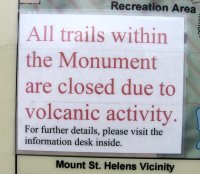
The local people in their conversations let us know
that they are very much aware of the possibility of a disaster with the
volcanic actions in the mountains from Northern California on up through
this section of Oregon. The old lava beds are strung out up
and down this section. The ancient lava
flows are right up close to the highways in areas.
Mount Lassen, Mount Hood and Shasta still have steam coming
out of their centers. Interesting listening to the local folks talk about the possibilities.
I'm not sure when one ends and the other begins but
the inner mountain range of California is called the High Sierras and
somewhere at the state line they begin to be referred to as the Cascade
Range. If I had the time I would look the information up and share it
with you. Maybe someone out there can explain this to me. In
California, the mountain range near the coast is
named the Las Padres. In Oregon
they are referred to as the
Coastal Range.
After we rode north of Klamath Lake
we entered evergreen timber country. Most of the times it is so thick we
are not able to see east or west beyond the large beautiful trees.
Occasionally we would see the signs of forest fires. When they
have a forest fire here there is nothing left but a few burned out
stumps and dirt. In places we saw where the forest service or others
came in and chainsawed the stumps down and re-seeded.
After lunch yesterday we came up on the Collier Logging
Museum. What a sight. While walking from exhibit to exhibit, I couldn't keep from thinking of
Larry Meadows. Larry is the man responsible for the Red River Museum
in Clay City, Kentucky. Of course he has a lot of help from the local
people. But as I was walking through this camp/museum I thought, boy if
Larry could spend some time with these people he would talk them out of
three or four tractor and trailer loads of their collection. One thing
becomes obvious real quick. These people were dealing with much larger
logs than the old loggers did in Eastern Kentucky. Some of their trees were eight and ten
feet in diameter. And their tools to pull them to the mills were
fascinating.
There was one piece of literature that I have to
share with you. It is painted on a large sign on the grounds.
"OH STRANGER, PONDER WELL, WHAT BREED OF MEN WERE
THESE CRUISERS, FALLERS, SKINNERS, OX, HORSE AND "CAT", CHOKESETTERS AND
THE REST WHO USED THESE TOOLS.
NO SUMMERS SEARING DUST COULD PARCH THEIR SOULS,
NOR BITTER BREATH OF WINTER CHILL THEIR HEARTS.
'TWAS NEVER SAID, "THEY WORKED FOR PAY ALONE." THO
IT WAS GOOD AND FREELY SPENT.
TOUGH JOBS TO LICK THEY WELCOMED WITH EACH DAY,
"WE'LL BURY THAT OLD MILL IN LOGS,"
THEIR BOAST.
SUCH MEN AS THEY HAVE MADE THIS COUNTRY GREAT,
BEYOND THE GRASP OF SMALLER, MEANER MEN.
PRAY GOD, OH STRANGER, OTHERS YET BE BORN WORTHY AS THEY TO WEAR A "LOGGERS BOOTS".
by: Nelson Reed
Tomorrow we will be watching the towering snow
capped peak of Mount Hood. And then watch it for several
days.
On May 12 I get a real treat. After visiting a long
lost cousin, Cindy Spore, in Port Orchard,
Washington which is a treat in itself, my youngest daughter, Natalie Anne, is
flying to Seattle to spend four days
with me. We plan on renting a car and seeing the Northwest and
Bowen Island, British Columbia, Canada.